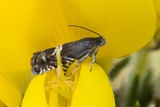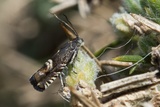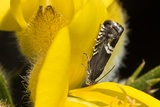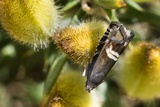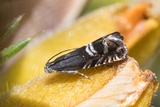Grapholita internana (Guenée, 1845) Species
Last modified: Nov. 25, 2025, 2:06 p.m.
A very rare and local species in Belgium. Hitherto only known from the coast (WV).
Details
- Classification
- Family: Tortricidae > Subfamily: Olethreutinae > Tribus: Grapholitini > Genus: Grapholita > Species: Grapholita internana
- Vernacular names
- Witvleugelbladroller (NL), Dark Gorse Piercer, White-underwing Piercer (EN)
- First mention in Belgium
- Anonymous 1902. Varia. — Revue mensuelle de la Société entomologique namuroise 2: 4, 12. On page 4.
- Status
-
Native
Distribution
Imago
Wingspan 9–10 mm. Forewing dark fuscous or grey being particularly glossy grey basally. Two white or cream dorsal striae. Four pairs of costal strigulae subtend metallic striae, this shade also present in the ocellus. The black line bordering the termen is interrupted by a small white patch. The males have the base of the hindwings white.
Caterpillar
Body cream-white with reddish transverse bands, the red coloration becoming stronger when fully fed, head brown, prothoragic plate pale brown, darker posteriorly, anal plate pale brown.
Bionomics
The larva lives in the pods and feeds on the seeds on the host plant. In September, when fully fed, it hibernates in a cocoon spun in the pod or amongst leaves.
the males are very active and can be observed around gorse bushes during the day, where their whitish hindwings are quite noticeable. The females are less active and have dusky hindwings.
Flight periods
The adults fly from mid-April towards early June.
Observed on
- Host plant (species):
- Ulex europaeus
The larva lives on Ulex europaeus.
Habitat
It inhabits heathlands or sandy places with areas with plenty of gorse.
